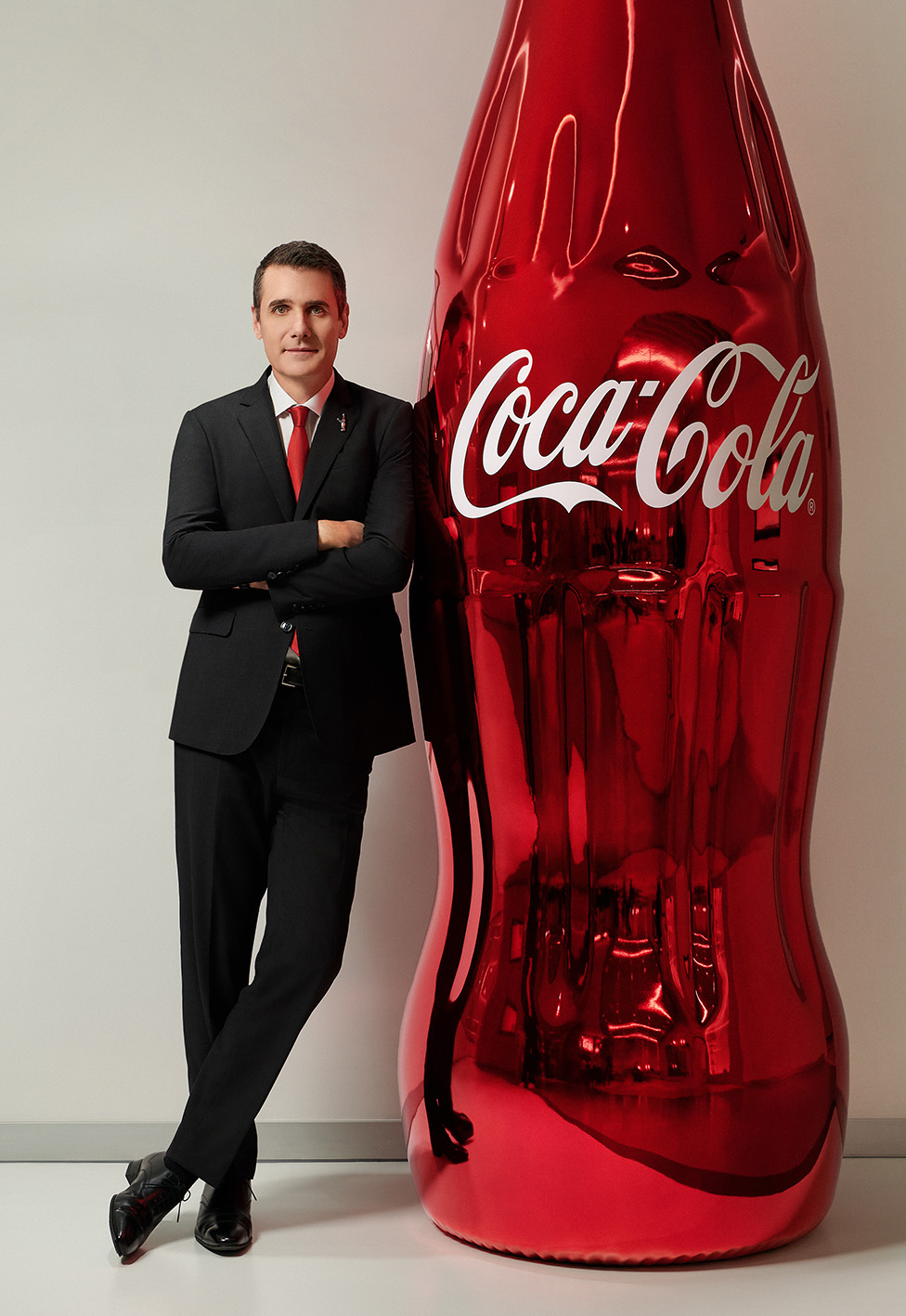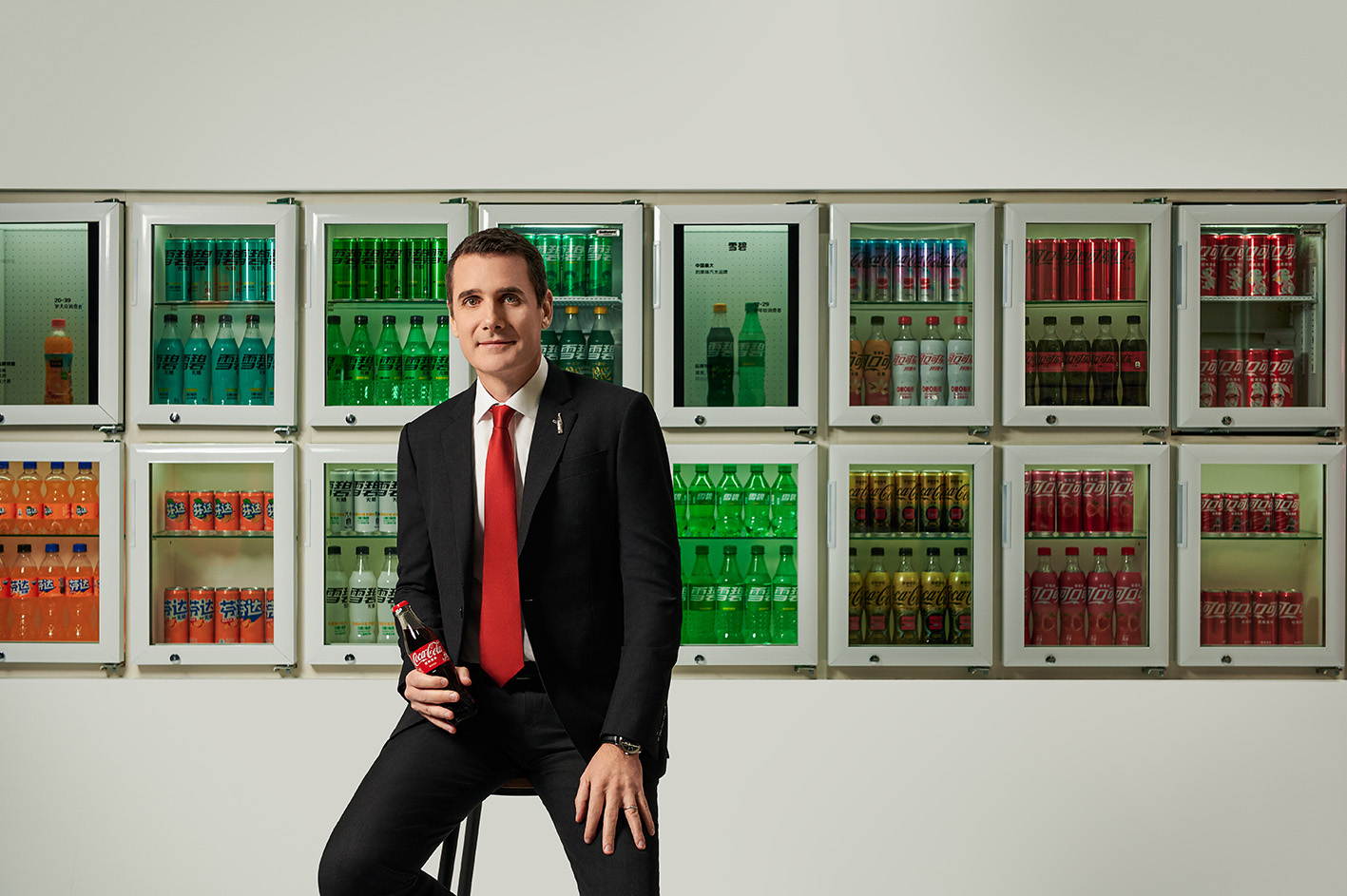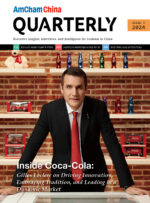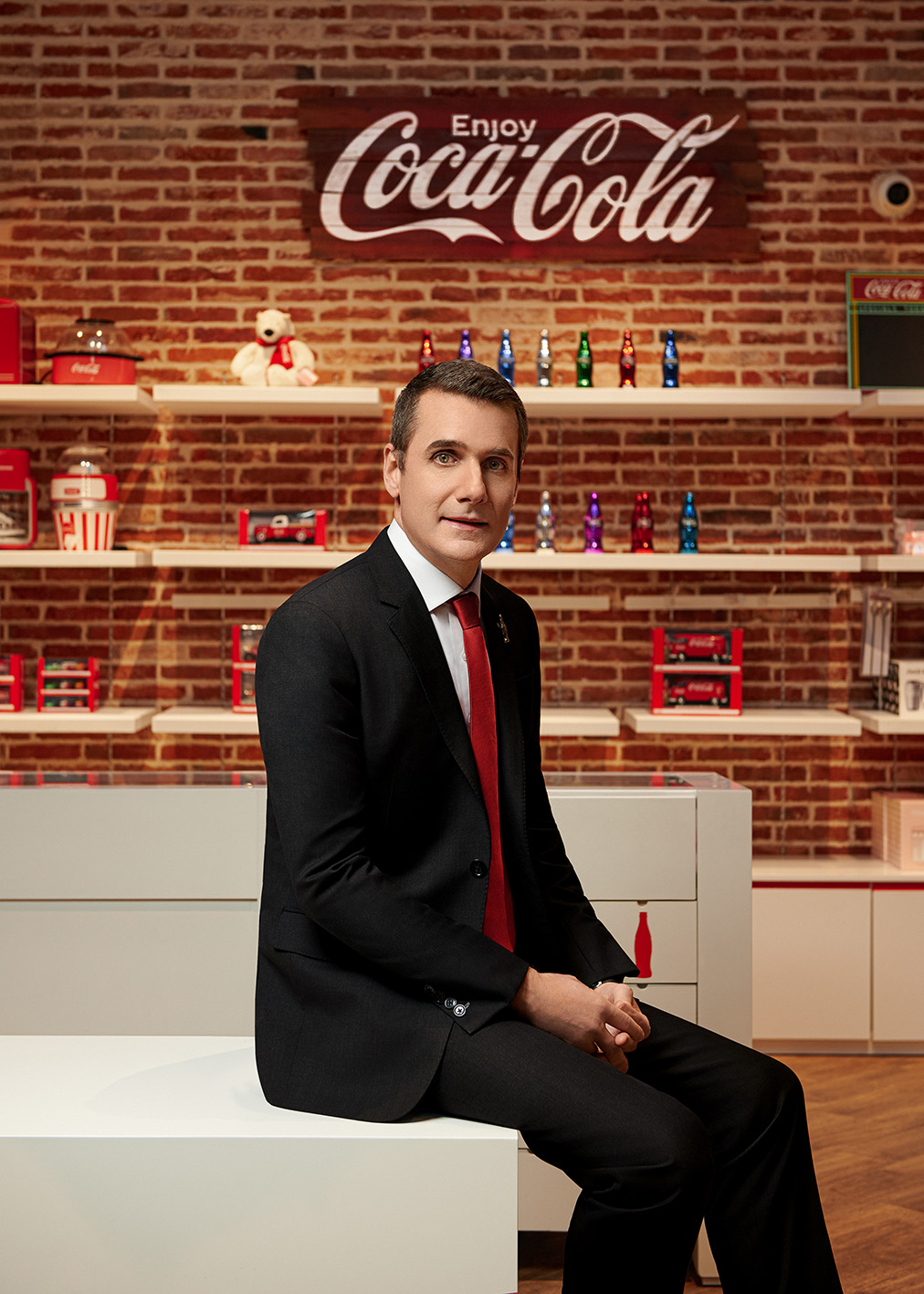A Splash of Innovation: Gilles Leclerc’s Strategy for Coca-Cola China
For over two decades, Gilles Leclerc has held key leadership roles at The Coca-Cola Company, driving growth and innovation across diverse markets. Now, as President of Coca-Cola Greater China and Mongolia, he brings his extensive experience – including previous leadership roles in China – to one of the world’s most dynamic and competitive regions. In this exclusive interview for the AmCham China Quarterly, Leclerc discusses how Coca-Cola blends tradition with cutting-edge innovation, leverages AI, and adapts to the evolving consumer landscape of China.

Gilles Leclerc is president of the Greater China and Mongolia Operating Unit of The Coca-Cola Company.
Previously, Leclerc served as president of The McDonald’s Division (TMD) for The Coca-Cola Company. He led a global organization that is responsible for building the strategic alliance with McDonald’s. Before that, Leclerc served as vice president, TMD International.
Leclerc joined Coca-Cola in 1998 and progressed through roles of expanding responsibilities in France, China, Singapore and the United States. He led global customer teams for Carrefour, Metro Group and Système U, and served as general manager, key customers, for Coca-Cola China. Leclerc received an MBA from the Barney School of Business at the University of Hartford in Connecticut.
Photo courtesy of Coca-Cola China
Coca-Cola is one of the most recognizable global brands. How does a heritage brand like Coca-Cola balance the need for innovation with maintaining its classic identity, especially in the dynamic Chinese market?
Gilles Leclerc: We would like our consumers to enjoy creative twists of classic Coca-Cola while always maintaining Coca-Cola’s core taste and values.
Innovation can also enhance branding. In 2022, our company unveiled a new platform dedicated to global innovations: Coca-Cola Creations. The idea was to take the iconic Coca-Cola brand and lend it to new expressions, driven by collaboration, creativity, and cultural connections.
The past month of September saw another innovative experience, the partnership between Coca‑Cola and the OREO brand brought by Coca-Cola Creations. Inspired by the ‘BESTIES’ culture around the world, the exclusive offerings lend the iconic Coca‑Cola brand to new creative expressions, unexpected flavors and immersive experiences anchored in Gen Z’s core passions.
AI is transforming industries globally. How is Coca-Cola leveraging AI in its operations and marketing in China to enhance consumer engagement and brand loyalty?
Gilles Leclerc: The Coca-Cola Company is one of the first FMCG companies to embrace AI. And China, being at the forefront of AI, offers many opportunities for us to exploit AI in evolving customer and consumer connections.
Last year, we introduced Coca-Cola Y3000 Zero Sugar to consumers. It was the first futuristic Coke flavor co-created by human creativity and AI. I’m proud that this innovation project was led by our team in China. It is a harbinger of what’s to come, where humanity and technology are more connected than ever.
We are continuously enhancing our supply chain AI capabilities. We have collaborated closely with our bottling partners, Swire Coca-Cola and COFCO Coca-Cola, to upgrade our production lines through the integration of digital technologies and AI. We are fostering AI talent development with a growing range of comprehensive digital and AI skills training initiatives for our employees. These initiatives aim to cultivate a culture of lifelong learning, encouraging employees to embrace the AI experimentation to drive scalability and value creation.
As the longest-standing partner of the Olympic Games, how did Coca-Cola contribute to the recent Paris 2024 Olympics, and how has this partnership evolved over time?
Gilles Leclerc: The Olympic Games have come a long way since the last time they were held in Paris (exactly 100 years ago in 1924!), from how athletes and fans hydrate to how company partnerships evolve. On-site hydration stations have significantly evolved since 1924, leading to Powerade becoming a prime hydration offering for Paris 2024.
We are proud of the 96-year partnership with the Olympic Movement and of our role as Worldwide Partner of the Olympic and Paralympic Games and Presenting Partner of the Paris 2024 Olympic Torch Relay.
Throughout this time, we’ve been a part of countless Olympic moments inspired by the pursuit of excellence, the possibility of opportunities and the spirit of competition. We refreshed athletes, officials, and fans with our diverse portfolio for Paris 2024, including Coca-Cola Trademark, which is favorite among Chinese consumers. And we created a platform “Celebrate Everyday Greatness” for the games to honor the big and small things athletes and fans do in their everyday life.
Did Coca-Cola introduce any new experiential strategies to engage consumers during the Paris Olympics?
Gilles Leclerc: We refreshed athletes and fans with the perfect range of drink options to fit every and all occasions or needs during the Olympic Games. We launched six comprehensive plans for five of our brands plus portfolio, meeting consumers’ need for diversity.
Beyond product offering, we engaged consumers through new technologies and cultural interactions. Globally, we created a platform for the games called “Celebrate Everyday Greatness” for the Paris Olympics. This platform provided a way for athletes and fans to honor the big and small things they do in their everyday lives that can create real magic and make a difference. Additionally, we teamed up with the International Olympic Committee (IOC) to create a new song, “Hello World,” which captures the exciting and celebratory spirit of the Olympic Games and engages the new, younger generation of fans. The song embodies the shared values of Coca-Cola and the IOC — togetherness, positivity, authenticity, and respect.
In the Chinese market, we initiated the campaign of “Embrace Differences, Win Together,” which invited Chinese consumers to celebrate the magic of people connection, with the simple act of hugs — athletes hugging each other and consumers hugging their loved ones. This was inspired by consumers’ desire for people of all nationalities, cultures, and generations to break down barriers, foster connections, and embrace differences.

Photo courtesy of Coca-Cola China
Coca-Cola is streamlining its core portfolio in China. What specific initiatives are being taken to optimize operations and product offerings?
Gilles Leclerc: Consumer-centricity has driven our growth over the past 138 years. China is the third largest market by volume for The Coca-Cola Company. We offer the Chinese consumers a total beverage portfolio with more than 20 brands and around 100 beverage choices.
In the future, we will focus more on categories loved by consumers such as sparkling, juice, RTD tea and coffee, to enhance our core business, maintain our strong presence in the market and fulfill our commitment to long-term growth.
We will also evolve the collaboration with local bottling partners, COFCO Coca-Cola and Swire Coca-Cola. Coca-Cola China system operates 46 plants with more than 49,000 employees, giving us local insight to improve our supply chain efficacy and effectiveness to better meet consumer demands
Given the rapid changes in consumer preferences, how is Coca-Cola adjusting its approach to meet the unique demands of Chinese consumers?
Gilles Leclerc: The rapidly evolving Chinese market with increasingly more segmented and diversified consumer demands is creating opportunities for our full portfolio brands and giving us more room to grow our business.
We are a consumer-centric company and consumers are at the heart of everything we do. We will continue to focus on the core portfolio loved by generations of consumers.
We are evolving the ways and platforms of consumer interaction. This helps us better understand consumers’ preferences and respond to their evolving needs with a growing range of beverages for every occasion. This year, to cater to the growing “on-the-go” and “City Walk” trends among younger consumers in China, we introduced pocket-size packaging for our flagship products – Coca-Cola, Sprite and Fanta.
Cultural connection with Chinese consumers is very important. The last three years have seen us launch Chinese zodiac Coke for Spring Festival. We hope to celebrate love, memories, and reunions.
What do you see as the biggest opportunities and challenges for Coca-Cola in the Chinese market over the next few years?
Gilles Leclerc: The challenge we face is the constantly changing market, which also brings new opportunities.
We will fully leverage the flexibility and breadth of our portfolio to meet the diverse and evolving consumer needs. We believe that sparkling flavors and the Coca-Cola brand have significant potential in the Chinese market, and we will continue to strengthen this category. We also have confidence in juice. We are proud that our Minute Maid, particularly its star product Minute Maid Orange Pulpy was originally developed by the China team and now sold in dozens of markets in the world. And then we look at the quickly expanding categories like ready-to-drink tea and coffee, which we will focus on as well.
We embrace new technologies that drive innovation, leveraging Generative AI to engage consumers through innovative campaigns. Last year, our China team spearheaded the introduction of Coca‑Cola Y3000 Zero Sugar, the first futuristic Coke flavor co-created with human creativity and AI.
There are tremendous growth opportunities in China, to which we have long term unwavering commitment. We look forward to further deepening our collaboration with our bottlers and other partners to provide our consumers the optimum beverage choices and experience.
Having worked across multiple countries, how does your global experience influence your leadership approach in China?
Gilles Leclerc: I have been with The Coca-Cola Company for more than 20 years. I’d like to highlight three key milestones of my experience. The first was during the initial decade of my career, where I gained invaluable operations experience working with a bottler in France. The second milestone was my seven years in China as the General Manager for Key Customers, which was my first international assignment. The China tenure has been a largely defining experience for me. The third was the opportunity to oversee a wide range of international markets, managing them from our headquarters in Atlanta. These experiences — local, international, and corporate headquarters — have shaped my leadership style and brought me to where I am today.
When the company tapped me to return to China, I didn’t hesitate — I was thrilled to come back. I see myself as a facilitator, guiding the business in the right direction. It’s important to remain humble and recognize that we can’t capture everything. My responsibility is to ensure that we continue to enhance our competitive advantages to better serve our customers and consumers.
With extensive experience in China, how has your understanding of the market evolved? What advice would you offer to others who are entering or working in this market?
Gilles Leclerc: The Chinese market is incredibly dynamic, especially for the beverage industry. Over the past decade, the market has expanded significantly, with demands increasing and diverse adoption of new technologies like AI unprecedentedly rapid. This constantly evolving market is absolutely challenging and fascinating at the same time.
For anyone who aspires to succeed in the Chinese market, I would say, it is essential to maintain open communication and keeping abreast of the latest trends.

This article is from the AmCham China Quarterly Magazine (Issue 3, 2024). To access the entire publication for free, sign up on our member portal here.

